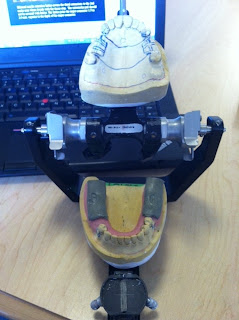Yes, I'm alive! I'm so sorry, I've been MIA from dealing with sickness, hospitalizations, and schoolwork that there's been no time for breathing let alone writing... But, I return with a vengeance! Haha, not exactly, but rather in time for Spring Break... ^_^
But, before I head off to AADR/IADR General Meeting in Seattle, WA (check out info here), here's a little update on what's been happening in dental land.
So, as our major fixed prosthodontics course has been winding down, we instead get removable partial prosthodontics. What's the difference? Fixed is when you get a crown or bridge (though many people want implants these days, some still want a bridge) while removable is like it sounds, a device with a few fake teeth that you can take out of your mouth (people also sometimes call them 'flippers'). Of the two, removable is the more mentally challenging and has what seems like an endless amount of steps. A major beginning of making an appliance for the mouth first requires seeing how a person bites and how their teeth normally line up in their mouth. Since photographs just don't cut it, what does a dentist use: an articulator.
 |
| My articulator with my first removable prosthodontics patient's casts and its bite registration . Looks kinda cute ^_^ |
Besides looking like a torture device, this little sucker can be both your best friend and worst enemy. After we take impressions of your mouth with that gooey material, we make stone casts and then place them on the articulator using plaster (and believe or not, one cannot 'plasterize' their cast XD). Now, this is really helpful: I can mess with this device and see where your teeth contact and how often by unhinging those silver clamps at the top and moving the two parts around. This lets me plan the design of a removable partial denture or even a crown/bridge set-up. However, things can go downhill quick if you plaster the casts wrong (which is quite easy actually) or you see that your patient's current mouth will not allow your awesome removable partial denture design... Thus, back to step 1.
But, the nice thing about pre-clinical years (aka. right now) is that everything tends to work out like candy and rainbows, so I don't have to panic about my patient's mouth being the equivalent to an unsolved Rubik's cube. While some patients won't ever see this, if you come to the dental school, we always use these for a treatment plan before starting dental work. It's actually kinda neat to see a replica of your mouth sitting of the table next to you. :-)
 |
| OPEN WIDE :-p |
Well, it's off to Seattle to present dental research and learn tons from other researchers! I'll post an entry about my experiences and I'll post a Flickr link to the pictures (assuming I figure it out...) ^_^





